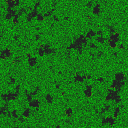
A chaotic model
of a forest fire shows
the spread of a wildfire.
Such behavior cannot
be described using
classical predictive
approaches.
| Deterministic Chaos - Tutorials |
 A chaotic model of a forest fire shows the spread of a wildfire. Such behavior cannot be described using classical predictive approaches. |
| The best
place to start is with this
introduction to how Edward Lorenz discovered deterministic
chaos. Before going further, let's introduce some terminology: The butterfly effect:
In
a system, this means an extreme dependence of the final outcome on the
initial conditions. Change the starting parameters just a
little,
and the outcome changes greatly. [Wikipedia
entry]
Linear system: A system which has the properties of superposition and scalability. To see what that means, assume that there are two initial conditions, x1(t) and x2(t), where t is the time. Let's call the end result of those initial conditions y1(t) and y2(t). x1(t)
is mapped onto y1(t) by an operator F: y1(t)
= F{x1(t)}.
Similarly, y2(t) = F{x2(t)}. Superposition means that y1(t) + y2(t) = F{x1(t) + x2(t)} (Note that the initial conditions are added together inside the function!) Scalability means that ay1(t) = F{ax1(t)} and by2(t) = F{bx2(t)} [Wikipedia entry] Non-linear system: A system which lacks superposition. This type of system is characterized by one or more non-linear terms which can't be broken down into a combination of linear terms. [Wikipedia entry] An dynamical system is one where F{x1(t)} maps to one and only one result. The same is true for F{x2(t)}. Because of this, a dynamical system is deterministic: if you put in the same initial condition, you will always get the same result. [Wikipedia entry] Chaos: a term that describes the behavior of some dynamical systems over time. Such systems exhibit an extreme sensitivity to initial conditions. [Wikipedia entry] An attractor is the set of points that a dynamical system covers over time. The Lorenz butterfly is an example of an attractor. [Wikipedia entry] A strange attractor is an attractor that arises from a chaotic dynamical system. The Lorenz butterfly is also a strange attractor because its set is extremely sensitive to initial conditions. [Wikipedia entry] A logistic map is a recursive map for a harmonic oscillator. It has the form: xn+1 = axn(1-xn) xn+1 is called an iterate of xn. The sequence of numbers produced by repeating this calculation are called the orbit of x. If a is small, the graph of the logistic map is regular, but if a is larger, then the map becomes chaotic. The logistic map is the simplest mathematical model that exhibits the period doubling route to chaos. [Wikipedia entry] A cobweb diagram
(a.k.a. cobweb
plot) is a graph of an iterative function like the
logistic map that
gives us resulting values without resorting to analytical or analytical
methods. A cobweb diagram is considered to be chaotic if it
doesn't settle down to a single or a finite set of final values.
[Wikipedia
entry]
A
bifurcation diagram is
a diagram of the final states of the cobweb diagram for
values of the coefficient a, usually for 1 < a < 4.
It shows the areas where the final states are stable,
oscillating or chaotic. It looks somewhat like a sideways
tree,
with the number of branches doubling (bifurcating) at certain points.
The bifurcation occurs at a = 3, a = 3.45, a = 3.54, a =
3.564.... The ratio of distances between consecutive
doublings is Feigenbaum's
delta constant.
As the number of doublings goes to infinity, Feigenbaum's
delta
constant -> 4.669201609102990671853... for a system with a
one-hump
quadratic maximum. [Wikipedia
entry]
Here's a slightly more technical glossary with nice illustrations. The Exploratorium website goes into a little more detail about Lorenz, chaos, and strange attractors. A Beginner's Guide to Chaos explains chaos, logistic maps, the Feigenbaum constant, and the Lorenz attractor. Logistic maps exhibit different behaviors depending on the function's growth rate. This web page explicitly shows each type of behavior and makes it easier to understand how logistic maps work in general. Get started with cobweb diagrams with this simple introduction. |
| Home
|
Overview
|
History
|
Tutorials
|
Multimedia
and
Lectures Examples and Simulations | Advanced Topics |